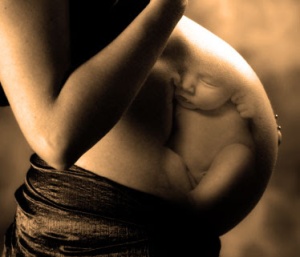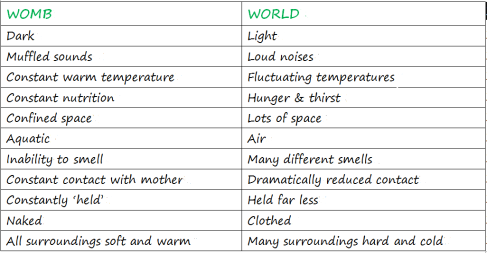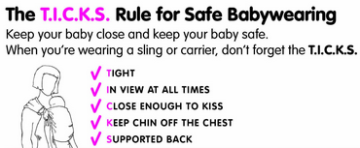Now some of you may agree, or disagree to this. It just makes sense to me most as a mother and provides a relief of course. These poor little things are so thrown off the moment they come to the world. They have just too much happening for their little bodies all at the same time. The first 2 really happens to me often but not always. I know that at the end of the day it's intuition that will guide us all. And of course, spending time :)
See if it works for you too!
Thank you Sarah Ockwell.
“My baby is only happy in my arms, the minute I put her down she cries”
“He sleeps really well but only when he’s laying on my chest, he hates his moses basket”
“She cries every time we lay her on her play mat”
“He hates going in his pram, he cries the second we put him in it”.
If I had a pound every time I heard these from a new parent I’d be a very rich lady by now! What amazes me though is that society in general doesn’t get it, they don’t get why so many babies need to be held by us to settle and what perplexes me even more is that we do spend so long trying to put them down! We spend more than time though, the ‘putting babies down’ industry is worth millions, rocking cribs, battery swings, vibrating chairs, heartbeat teddies and the list goes on………………having been a first time parent who bought all four of the items listed above I am embarrased to admit now it honestly didn’t enter into my head that perhaps the answer was to *not* put my baby down and I certainly didn’t consider why these things might help. It took me a long time to understand and empathise with my baby, to see the world through his eyes so to speak.
“Empathy: the intellectual identification with
or vicarious experiencing ofthe feelings,
thoughts, or attitudes of another.”
To empathise with our newborns feelings we need to put ourselves in their place, to imagine experiencing their world – but which world? The world they have spent most of their life in, their ‘womb world’ or the world they are in now – our world. To fully understand we must appreciate the enormous transition they have made – a concept known to many as ‘The Fourth Trimester’ -some make the womb to world transition easily, others less so and it is this latter group in particular “the clingy babies” we can learn so much from through this concept.
Pretty different huh? On top of this the big thing to understand is that in utero the baby’s world was constant, each day was the same, the stimulation didn’t change, but now they are born each day is different – ever changing, ever stimulating!
The concept of the fourth trimester helps us to understand the transition a newborn must make over their first few weeks earthside and once we understand we find so many ways we can help – but to me the most important facet of the fourth trimester is parental understanding and empathy, once that exists everything else will flow naturally.
Here are some common newborn calming techniques that tend to work quite well, but remember each and every baby is different, if you don’t already know, you will soon learn what your baby likes best and that’s what matters, that it is unique to *your* baby. Prescriptive ‘do this/don’t do this’ baby calming lists don’t help anybody – because they forget they are dealing with individuals – both parents and babies! Some things on this list will be inappropriate for you and your baby, some simply won’t work, some you won’t like – and that’s OK! because really it isn’t about these tips it’s about you and your baby getting to know each other!
Movement
The womb is a constantly moving space, Braxton Hicks would squeeze your baby at the end of pregnancy and each time you moves your baby was wobbled around inside. Imagine how walking upstairs feels for a baby in utero! Babies tend to love movement but so often we put them down somewhere completely still. You could try dancing, swaying from side to side, going for an exaggerated quick walk or bumpy car ride.
Skin to Skin Contact
Bed-Sharing
Sharing a bed with your baby is an amazing way of getting more sleep for everyone, babies are generally much calmer and sleep more easily if they sleep with you in your bed, yet it is such a taboo topic and although 60% of parents will share a bed with their baby at some point it’s a subject that makes society very uncomfortable, but…it is an *amazing* baby calmer! It’s really important that you think about how bedsharing will work and follow some important safety guidelines HERE.
Swaddling
Imagine how snug your baby was at the very end of your pregnancy inside of you – now imagine how strange it must feel to them after they have been born and have so much space around them! The absolutely best thing you can do is to envelop your baby in your arms, but for times when you don’t want to or indeed can’t then swaddling is an option. Swaddling is becoming increasingly popular, however there are important safety guidelines to be followed if you choose to swaddle your baby, if you are breastfeeding please make sure feeding is established before swaddling and take care not to miss your baby’s hunger cues if you are feeding on demand:
- Never swaddle over your baby’s head or near his face
- Never swaddle your baby if he is ill or has a fever
- Make sure your baby does not overheat and only swaddle with a breathable/thin fabric
- Only swaddle your baby until he can roll over**
- Always place your baby to sleep on his back
- Do not swaddle tightly across your baby’s chest
- Do not swaddle tightly around your baby’s hips and legs, his legs should be free to “froggy up” into a typical newborn position.
- Lastly start to swaddle as soon as possible, do not swaddle a 3 month old baby if he has not been swaddled before.
Babywearing
Babywearing is a great way for dads to bond with babies!
It is quite common for a baby to cry once placed in a sling, this does not mean that they hate the sling – it just means that you need to move, so get dancing! As with swaddling,babywearing is becoming increasingly popular, however there are important safety guidelines to be followed, the TICKS acronym below neatly sums them all up:
Position
The “tiger in the tree” position below, taken from baby yoga, is often magical, stopping a crying baby in an instant!
Noise
Babies love sound, but for many not the sound you might think. For many babies a hoover is much more calming to a baby than a lullaby. A special white noise CD, such as THIS, can be played on loop whilst your baby sleeps to help keep them calm.
Feed
If your baby is hungry nothing will calm him, so watch for his hunger cues. Feeding is always better if it is baby led, not led by a routine – whether you are breast or bottle feeding. Remember as well that your baby may not always be hungry for a full feed, they may want a quick drink, a quick snack or just some comfort sucking. Babies also find sucking the ultimate relaxation and comfort tool. Sucking helps a baby’s skull bones to return to their normal position after birth as well as providing them with comfort and security. If you are not breastfeeding you might find your baby will relax when given a dummy/pacifier.
Deep Bathing
The womb is a wet, warm place. The world as we know it is dry and cold! Sometimes a nice deep, warm bath can stop a baby’s tears in seconds – even better if mummy or daddy goes in the big bath with baby too as skin to skin contact is a wonderful baby calmer.
Outside
If all else fails many babies stop crying the minute they hit the open air – I’m not sure if this is because we are usually moving (e.g.: walking over cobbles with the buggy/ bouncing in a sling and the drone and movement of a car) or because of the change in air – but it works!
What have you found calms your newborn?
















0 comments:
Post a Comment